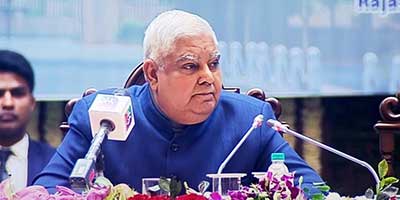Date: 16/01/2023
Relevance: GS-2: Indian Constitution—Historical Underpinnings, Evolution, Features, Amendments, Significant Provisions, and Basic Structure.
Key Phrases: National Judicial Appointments Commission Act, basic structure doctrine, parliamentary sovereignty, Keshavananda Bharati v State of Kerala, democratic principles.
Why in News?
- Vice President sparked a debate on the separation of powers between the executive and the judiciary.
What is the issue?
- He criticized the Supreme Court again for using the doctrine of basic structure to strike down the constitutional amendment that introduced the National Judicial Appointments Commission Act.
- In his view, the basic structure doctrine has usurped parliamentary sovereignty and goes against the democratic imperative that the elected legislature should reign supreme.
- Vice-President’s remarks questioning the basic structure doctrine propounded in the landmark Keshavananda Bharati case (1973) does not reflect the correct position of law.
Limitations of parliamentary legislation:
- It is fairly well-known that parliamentary legislation is subject
to two limitations under the Constitution of India.
- One is by judicial review, or the power of constitutional courts to review legislation for possible violation of any fundamental right. It is set out in Article 13, under which laws inconsistent with or in derogation of fundamental rights are void.
- Another is that no amendment to the Constitution should have the effect of destroying any of its basic features.
What is the basic structure doctrine?
- The Doctrine of Basic Structure is a form of judicial review that is used to test the legality of any legislation by the courts.
- The doctrine was evolved by the Supreme Court in the 1973 landmark ruling in Keshavananda Bharati v State of Kerala. In a 7-6 verdict, a 13-judge Constitution Bench ruled that the ‘basic structure’ of the Constitution is inviolable, and could not be amended by Parliament.
- If a law is found to “damage or destroy” the “basic features of the Constitution”, the Court declares it unconstitutional. The test is applied to constitutional amendments to ensure the amendment does not dilute the fundamentals of the Constitutional itself.
- The test is widely regarded as a check on majoritarian impulses of the Parliament since it places substantive limits on the power to amend the Constitution.
What are the basic features of the Indian Constitution?
- In the Keshavananda ruling, the Supreme Court cited several aspects of the Constitution that could be identified as “basic features” of the document but added that it was not an exhaustive list.
- For example, judicial review, rule of law, federalism, and democratic republic structure are identified as basic features.
- In the 2015 ruling where the Supreme Court struck down the National Judicial Appointments Commission Act and the related Constitutional Amendment, “judicial independence” was identified as a basic feature of the Constitution.
- The five-judge bench struck down the amendment passed with an overwhelming majority by the Parliament (with just one member abstaining) by applying the basic structure doctrine. This, the Vice President referred to as the judiciary undermining the sovereignty of the Parliament.
Does basic structure doctrine undermine parliamentary sovereignty?
- The idea that the basic structure doctrine undermines parliamentary sovereignty is simply wrong.
- Parliament is sovereign in its domain, but it is still bound by the limitations imposed by the Constitution.
- The basic structure doctrine had helped save the Constitution from being undermined through the misuse of a parliamentary majority.
- The main purpose of the doctrine is to ensure that some fundamental features of the Constitution are not legislated out of existence.
- It has been invoked to strike down amendments only in a few cases, but many others have survived basic structure challenges.
- Parliamentary majority is transient, but essential features of the Constitution such as the rule of law, parliamentary form of government, separation of powers, the idea of equality, and free and fair elections ought to be perennially protected from legislative excess.
- It may be open to a new Constituent Assembly to come up with another constitution that changes these fundamental concepts, but a legislature formed under the current Constitution cannot be allowed to change its core identity.
Conclusion:
- The basic structure doctrine has been used by the Supreme Court in various judgments to preserve the sanctity and basic character of the Constitution.
- The doctrine has evolved through SC judgments and is still expanding. It forces constitutional amendments to conform to certain standards or values that maintain the sanctity and spirit of the Constitution.
- Judiciary does not take away amendment powers or power to make laws, it just places certain restrictions in order to enhance democratic principles.
- It places restrictions on any institution gaining immense power or power over others. It helps in maintaining the supremacy of the constitution and its principles.
Source: The Hindu
Mains Question:
Q. Does the basic structure doctrine undermine parliamentary sovereignty? Critically analyse in the context of the recent remark by the Vice President of India on "basic structure doctrine."






















